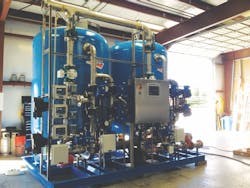About the author:
AdEdge Water Technologies, www.adedgetechnologies.com, 678.835.0052
In late 2011, the U.S. Army Corps of Engineers (USACE) approved plans to install a new well and build a new water treatment facility for the city of Roswell, Ga. Barlovento LLC was selected during a competitive bidding process to provide an iron and manganese removal system for the new water supply.
AdEdge Water Technologies LLC was contracted to design, manufacture and commission an iron and manganese treatment plant for the city. The raw water has an iron concentration greater than 0.8 mg/L and a manganese concentration greater than 0.1 mg/L, exceeding the U.S. EPA’s standards of 0.3 mg/L iron and 0.05 mg/L manganese.
Treatment System
The AdEdge treatment system was designed to treat up to 400 gal per minute to serve the water supply wells by removing iron and manganese to the EPA standards. The treatment system was packaged in a compact, skid-mounted unit—AdEdge model APU26-7272CS-2-AVH—utilizing two 72-in.-diameter carbon steel vessels in parallel. Each vessel was loaded with AdEdge ADGS+ media and appropriate support media. This media is a manganese dioxide coated media used for the removal of arsenic, iron, manganese and hydrogen sulfide. System features include:
• Pre-chlorination using sodium hypochlorite to oxidize iron and manganese for optimal removal;
• Sequestering chemical feed pumps that inject ortho- and polyphosphates downstream of the APU system to act as a corrosion inhibitor in the distribution piping;
• Post-chlorination for final disinfection in the distribution system;
• Inline turbidity, pH and chlorine influent and effluent monitoring equipment;
• Differential pressure monitoring, local pressure gauges, flow sensors and a central hydraulic panel; and
• System control provided by a programmable logic controller (PLC) and a human machine interface screen. The PLC provides control of well pumps and chemical dosing pumps, as well as remote operator plant control.
Performance
The treatment system has consistently met effluent treatment goals of less than 0.3 mg/L for iron and less than 0.05 mg/L for manganese since it began operation in late 2012.



